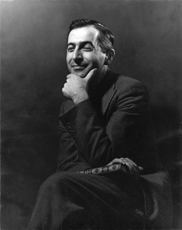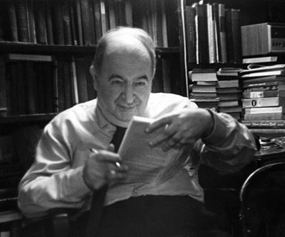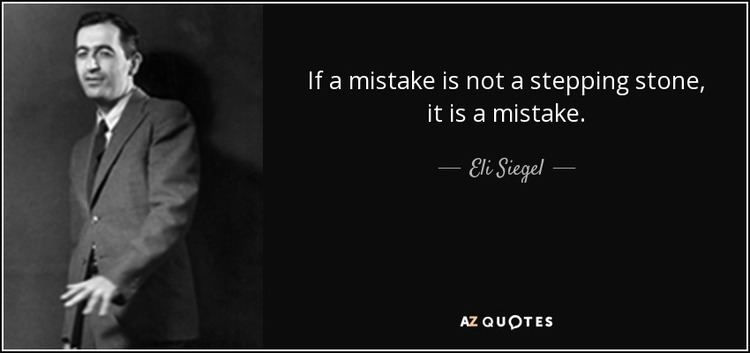Name Eli Siegel Role Poet | Education Balti City College | |
 | ||
Nominations National Book Award for Poetry Books Self and world, Hot Afternoons Have Bee, Hail - American development, Damned welcome, The Frances Sanders l | ||
Judge D'Army Bailey recites poem by Eli Siegel -Interview with Alice Bernstein
Eli Siegel (August 16, 1902 – November 8, 1978) was the poet, critic, and educator who founded Aesthetic Realism, the philosophy that sees reality as the aesthetic oneness of opposites. An idea central to this philosophy—that every person, place or thing in reality has something in common with all other things—was expressed in his award-winning poem, "Hot Afternoons Have Been in Montana."
Contents
- Judge DArmy Bailey recites poem by Eli Siegel Interview with Alice Bernstein
- Hymn To Jazz And The Like Eli Siegel Poem
- Life
- Aesthetic Realism
- Books
- Poetry
- Comments on Siegels work
- Epitaph
- References

Two highly acclaimed volumes of poetry were also published during his lifetime, and in 1958, he was nominated for the Pulitzer Prize for Poetry. Siegel’s philosophic works include Self and World: An Explanation of Aesthetic Realism, and Definitions, and Comment: Being a Description of the World. His teaching of Aesthetic Realism spanned almost four decades and included thousands of extemporaneous lectures on poetry, the arts and sciences, religion, economics, and national ethics, as well as lessons to individuals and general classes dealing with the aesthetic and ethical questions of everyday life.

His lecture on the poetry of William Carlos Williams, which Williams attended, is published in The Williams-Siegel Documentary, and his lectures on Henry James's The Turn of the Screw were edited into a critical consideration titled James and the Children. Siegel’s philosophy, and his statement, “The world, art, and self explain each other: each is the aesthetic oneness of opposites,” has influenced artists, scientists, and educators.
Hymn To Jazz And The Like (Eli Siegel Poem)
Life
Born in Dvinsk, Latvia, Siegel emigrated to the United States in 1905 with his parents, Mendel and Sarah (Einhorn) Siegel. The family settled in Baltimore, Maryland, where Siegel attended Baltimore City College and joined the speech and debate team now referred to as the Bancroft/Carrollton-Wight Literary Societies. He contributed to the senior publication, The Green Bag and graduated in 1919. In 1922, together with V.F. Calverton [George Goetz], he co-founded The Modern Quarterly, a magazine in which his earliest essays appeared, including “The Scientific Criticism” (Vol. I, No. 1, March 1923) and “The Equality of Man” (Vol. I, No. 3, December 1923).
In 1925, his "Hot Afternoons Have Been in Montana" was selected from four thousand anonymously submitted poems as the winner of The Nation's esteemed poetry prize. The magazine's editors described it as "the most passionate and interesting poem which came in—a poem recording through magnificent rhythms a profound and important and beautiful vision of the earth on which afternoons and men have always existed." The poem begins:
"Hot Afternoons" was controversial; the author's innovative technique in this long, free-verse poem tended to polarize commentators, with much of the criticism taking the form of parody. "In Hot Afternoons," Siegel later explained, "I tried to take many things that are thought of usually as being far apart and foreign and to show, in a beautiful way, that they aren’t so separate and that they do have a great deal to do with one another."
Siegel continued writing poetry throughout his life, but devoted the majority of his time over the next decades to developing the philosophy he later called Aesthetic Realism. After moving to New York City, he became a member of the Greenwich Village poets, famous for his dramatic readings of Hot Afternoons and other poems. His two-word poem, One Question, won recognition in 1925 as the shortest poem in the English language. It appeared in the Literary Review of the New York Evening Post :
For several years in the 1930s, Siegel served as master of ceremonies for regular poetry readings that were well known for combining poetry and jazz. He was also a regular reviewer for Scribner's magazine and the New York Evening Post Literary Review. In 1938, Siegel began teaching poetry classes with the view that "what makes a good poem is like what can make a good life." In 1941, students in these classes asked him to give individual lessons in which they might learn about their own lives. These were the first Aesthetic Realism lessons.
In 1944, Siegel married Martha Baird (University of Iowa), who had begun studying in his classes the year before. Baird would later become Secretary of the Society for Aesthetic Realism. [2]
In 1946, at Steinway Hall in New York City, Siegel began giving weekly lectures in which he presented the philosophy he first called Aesthetic Analysis (later, Aesthetic Realism) "a philosophic way of seeing conflict in self and making this conflict clear to a person so that a person becomes more integrated and happier." From 1941 to 1978, he gave many thousand lectures on poetry, history, economics—a wide variety of the arts and sciences. And he gave thousands of individual Aesthetic Realism lessons to men, women, and children. In these lessons the way of seeing the world based on aesthetics—which is Aesthetic Realism—was taught.
In 1951, William Carlos Williams read Siegel's "Hot Afternoons Have Been in Montana" again, and wrote to Martha Baird: "Everything we most are compelled to do is in that one poem." Siegel, he wrote, "belongs in the very first rank of our living artists." The prize poem became the title poem of Siegel's first volume, Hot Afternoons Have Been in Montana: Poems, nominated for a National Book Award in 1958. A decade later, his second volume, Hail, American Development, also met with critical acclaim. "I think it's about time Eli Siegel was moved up into the ranks of our acknowledged Leading Poets," wrote Kenneth Rexroth, in the New York Times. Walter Leuba described Siegel's poems as "alive in a burning honesty and directness" and yet, having "exquisite emotional tact." He pointed to these lines, from "Dear Birds, Tell This to Mothers":
At the age of 76, Siegel had an operation for a benign prostatic condition. He called it "the operation so disastrous to me." As a result, he lost the use of his feet and was unable to sleep. According to Ellen Reiss, Aesthetic Realism Chairman of Education, the operation was "the cause of his dying 5-1/2 months later."
Aesthetic Realism
The basis of Aesthetic Realism is the principle, "The world, art, and self explain each other: each is the aesthetic oneness of opposites".[3] In the book, Aesthetic Realism: We Have Been There, six working artists explain this principle in life and their own craft. Reviewing them, the Library Journal tells us: "Heraclitus, Aristotle, Kant, Hegel, and even Martin Buber have posited contraries and polarities in their philosophies. Siegel, however, seems to be the first to demonstrate that 'all beauty is the making one of the permanent opposites in reality'." (1 September 1969) [4]
The ethics Siegel taught—"the art of enjoying justice"—includes this definition of good will: "The desire to have something else stronger and more beautiful, for this desire makes oneself stronger and more beautiful". Good will is necessary, he stated, for a person to like him– or herself: "This desire is the fundamental thing in human consciousness". (The Right of Aesthetic Realism to Be Known, issue no. 121)
The Aesthetic Realism Foundation continues to teach the philosophy that Siegel founded. The Foundation gives consultations in New York City and by telephone and Skype internationally. The Aesthetic Realism Online Library publishes poems, essays, definitions, lectures, and reviews by Eli Siegel.
Books
Among Siegel's many published works are:
Poetry
Comments on Siegel's work
William Carlos Williams wrote of the poem and title Hot afternoons Have been in Montana , "I say definitely that that single poem, out of a thousand others written in the past quarter century, secures our place in the cultural world".[6] John Henry Faulk, speaking of the poems in this book, said on CBS radio, "Eli Siegel makes a man glad he's alive".William Carlos Williams was an early supporter of Siegel's poetry and defender of his views. Williams wrote:
I can't tell you how important Siegel's work is in the light of my present understanding of the modern poem. He belongs in the very first rank of our living artists.
And Williams continued:
The other side of the picture is the extreme resentment that a fixed, sclerotic mind feels confronting this new. It shows itself by the violent opposition Siegel received from the "authorities" whom I shall not dignify by naming and after that by neglect https://web.archive.org/web/20050414090805/http://www.elisiegel.net/poetry/WilliamsLetter1951.htm "Something to Say", ed. by J.E.B. Breslin, New Directions]).
Kenneth Rexroth wrote in the New York Times Book Review of Hail, American Development, "all the poems with the same incomparable sensibility at work saying things nobody else could say", wrote ; adding, "Eli Siegel's translations of Baudelaire and his commentaries on them rank him with the most understanding of the Baudelaire critics in any language". (23 March 1969) [7]
In Contemporary Authors Ellen Reiss, academic head of the Aesthetic Realism Foundation, stated (in a book published by Definition Press, said Foundation's publishing arm):
Eli Siegel's work, which in time became Aesthetic Realism, was the cause of some of the largest praise, the largest love in persons, and also the largest resentment... In writing an entry about [him] for Contemporary Authors, you are somewhat in the position you would be writing an entry on the poet John Keats in 1821. That is, if you were to rely on what was said of Keats by most established critics (critics now remembered principally for their injustice to one of the greatest English writers), you would present the author of `Ode to a Nightingale' as a presumptuous `Cockney poet' whose works were `driveling idiocy.' In writing about Eli Siegel [now], you are writing about a contemporary who is great; who all his life met what William Carlos Williams described him as meeting, `the extreme resentment that a fixed, sclerotic mind feels confronting this new'; who now, after his death, is beginning, just barely beginning, to be seen with something like fairness.
Huntington Cairns, Secretary of the National Gallery of Art in Washington, D.C., described Siegel's place in the understanding of aesthetics—the branch of philosophy which studies beauty—as follows:
I believe that Eli Siegel was a genius. He did for aesthetics what Spinoza did for ethics. [8]
Donald Kirkley wrote in the [Baltimore Sun|Baltimore Sun] (1944) reporting on Siegel's reaction to his 1925 national fame,
Baltimore friends close to him at the time will testify to a certain integrity and steadfastness of purpose which distinguished Mr. Siegel... He refused to exploit a flood of publicity which was enough to float any man to financial comfort..."[9]
And William Carlos Williams also wrote,
Only today do I realize how important that poem ["Hot Afternoons Have Been in Montana"] is in the history of our development as a cultural entity." [10]
In 2002 the city of Baltimore placed a plaque in Druid Hill Park to commemorate the centennial of Eli Siegel's birth. That same year Representative Elijah E. Cummings read a tribute to Siegel in the United States House of Representatives.
Epitaph
The following are lines from Hot Afternoons Have Been in Montana, one of the poems which Selden Rodman wrote "say more (and more movingly) about here and now than any contemporary poems I have read". (17 August 1957 Saturday Review) These lines stand for what Ellen Reiss has described as Siegel's "beautiful, faithful, passionate, critical, loving attention to the world and humanity".[11]
